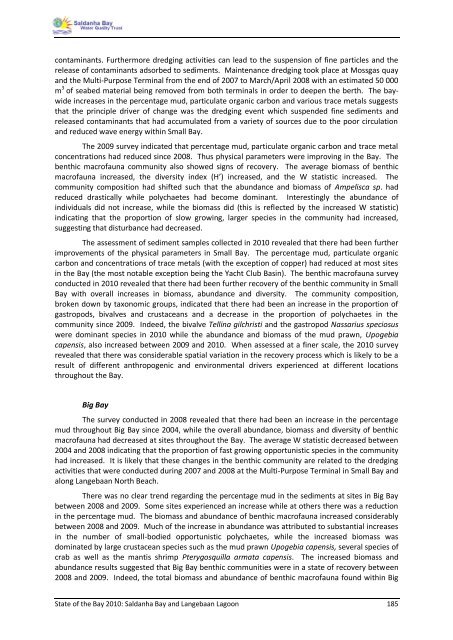State of the Bay Report 2010-Final - Anchor Environmental
State of the Bay Report 2010-Final - Anchor Environmental
State of the Bay Report 2010-Final - Anchor Environmental
You also want an ePaper? Increase the reach of your titles
YUMPU automatically turns print PDFs into web optimized ePapers that Google loves.
contaminants. Fur<strong>the</strong>rmore dredging activities can lead to <strong>the</strong> suspension <strong>of</strong> fine particles and <strong>the</strong><br />
release <strong>of</strong> contaminants adsorbed to sediments. Maintenance dredging took place at Mossgas quay<br />
and <strong>the</strong> Multi-Purpose Terminal from <strong>the</strong> end <strong>of</strong> 2007 to March/April 2008 with an estimated 50 000<br />
m 3 <strong>of</strong> seabed material being removed from both terminals in order to deepen <strong>the</strong> berth. The baywide<br />
increases in <strong>the</strong> percentage mud, particulate organic carbon and various trace metals suggests<br />
that <strong>the</strong> principle driver <strong>of</strong> change was <strong>the</strong> dredging event which suspended fine sediments and<br />
released contaminants that had accumulated from a variety <strong>of</strong> sources due to <strong>the</strong> poor circulation<br />
and reduced wave energy within Small <strong>Bay</strong>.<br />
The 2009 survey indicated that percentage mud, particulate organic carbon and trace metal<br />
concentrations had reduced since 2008. Thus physical parameters were improving in <strong>the</strong> <strong>Bay</strong>. The<br />
benthic macr<strong>of</strong>auna community also showed signs <strong>of</strong> recovery. The average biomass <strong>of</strong> benthic<br />
macr<strong>of</strong>auna increased, <strong>the</strong> diversity index (H’) increased, and <strong>the</strong> W statistic increased. The<br />
community composition had shifted such that <strong>the</strong> abundance and biomass <strong>of</strong> Ampelisca sp. had<br />
reduced drastically while polychaetes had become dominant. Interestingly <strong>the</strong> abundance <strong>of</strong><br />
individuals did not increase, while <strong>the</strong> biomass did (this is reflected by <strong>the</strong> increased W statistic)<br />
indicating that <strong>the</strong> proportion <strong>of</strong> slow growing, larger species in <strong>the</strong> community had increased,<br />
suggesting that disturbance had decreased.<br />
The assessment <strong>of</strong> sediment samples collected in <strong>2010</strong> revealed that <strong>the</strong>re had been fur<strong>the</strong>r<br />
improvements <strong>of</strong> <strong>the</strong> physical parameters in Small <strong>Bay</strong>. The percentage mud, particulate organic<br />
carbon and concentrations <strong>of</strong> trace metals (with <strong>the</strong> exception <strong>of</strong> copper) had reduced at most sites<br />
in <strong>the</strong> <strong>Bay</strong> (<strong>the</strong> most notable exception being <strong>the</strong> Yacht Club Basin). The benthic macr<strong>of</strong>auna survey<br />
conducted in <strong>2010</strong> revealed that <strong>the</strong>re had been fur<strong>the</strong>r recovery <strong>of</strong> <strong>the</strong> benthic community in Small<br />
<strong>Bay</strong> with overall increases in biomass, abundance and diversity. The community composition,<br />
broken down by taxonomic groups, indicated that <strong>the</strong>re had been an increase in <strong>the</strong> proportion <strong>of</strong><br />
gastropods, bivalves and crustaceans and a decrease in <strong>the</strong> proportion <strong>of</strong> polychaetes in <strong>the</strong><br />
community since 2009. Indeed, <strong>the</strong> bivalve Tellina gilchristi and <strong>the</strong> gastropod Nassarius speciosus<br />
were dominant species in <strong>2010</strong> while <strong>the</strong> abundance and biomass <strong>of</strong> <strong>the</strong> mud prawn, Upogebia<br />
capensis, also increased between 2009 and <strong>2010</strong>. When assessed at a finer scale, <strong>the</strong> <strong>2010</strong> survey<br />
revealed that <strong>the</strong>re was considerable spatial variation in <strong>the</strong> recovery process which is likely to be a<br />
result <strong>of</strong> different anthropogenic and environmental drivers experienced at different locations<br />
throughout <strong>the</strong> <strong>Bay</strong>.<br />
Big <strong>Bay</strong><br />
The survey conducted in 2008 revealed that <strong>the</strong>re had been an increase in <strong>the</strong> percentage<br />
mud throughout Big <strong>Bay</strong> since 2004, while <strong>the</strong> overall abundance, biomass and diversity <strong>of</strong> benthic<br />
macr<strong>of</strong>auna had decreased at sites throughout <strong>the</strong> <strong>Bay</strong>. The average W statistic decreased between<br />
2004 and 2008 indicating that <strong>the</strong> proportion <strong>of</strong> fast growing opportunistic species in <strong>the</strong> community<br />
had increased. It is likely that <strong>the</strong>se changes in <strong>the</strong> benthic community are related to <strong>the</strong> dredging<br />
activities that were conducted during 2007 and 2008 at <strong>the</strong> Multi-Purpose Terminal in Small <strong>Bay</strong> and<br />
along Langebaan North Beach.<br />
There was no clear trend regarding <strong>the</strong> percentage mud in <strong>the</strong> sediments at sites in Big <strong>Bay</strong><br />
between 2008 and 2009. Some sites experienced an increase while at o<strong>the</strong>rs <strong>the</strong>re was a reduction<br />
in <strong>the</strong> percentage mud. The biomass and abundance <strong>of</strong> benthic macr<strong>of</strong>auna increased considerably<br />
between 2008 and 2009. Much <strong>of</strong> <strong>the</strong> increase in abundance was attributed to substantial increases<br />
in <strong>the</strong> number <strong>of</strong> small-bodied opportunistic polychaetes, while <strong>the</strong> increased biomass was<br />
dominated by large crustacean species such as <strong>the</strong> mud prawn Upogebia capensis, several species <strong>of</strong><br />
crab as well as <strong>the</strong> mantis shrimp Pterygosquilla armata capensis. The increased biomass and<br />
abundance results suggested that Big <strong>Bay</strong> benthic communities were in a state <strong>of</strong> recovery between<br />
2008 and 2009. Indeed, <strong>the</strong> total biomass and abundance <strong>of</strong> benthic macr<strong>of</strong>auna found within Big<br />
<strong>State</strong> <strong>of</strong> <strong>the</strong> <strong>Bay</strong> <strong>2010</strong>: Saldanha <strong>Bay</strong> and Langebaan Lagoon 185

















